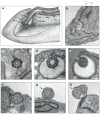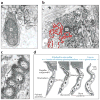The Trypanosoma brucei flagellum: moving parasites in new directions
- PMID: 19575562
- PMCID: PMC3821760
- DOI: 10.1146/annurev.micro.091208.073353
The Trypanosoma brucei flagellum: moving parasites in new directions
Abstract
African trypanosomes are devastating human and animal pathogens. Trypanosoma brucei rhodesiense and T. b. gambiense subspecies cause the fatal human disease known as African sleeping sickness. It is estimated that several hundred thousand new infections occur annually and the disease is fatal if untreated. T. brucei is transmitted by the tsetse fly and alternates between bloodstream-form and insect-form life cycle stages that are adapted to survive in the mammalian host and the insect vector, respectively. The importance of the flagellum for parasite motility and attachment to the tsetse fly salivary gland epithelium has been appreciated for many years. Recent studies have revealed both conserved and novel features of T. brucei flagellum structure and composition, as well as surprising new functions that are outlined here. These discoveries are important from the standpoint of understanding trypanosome biology and identifying novel drug targets, as well as for advancing our understanding of fundamental aspects of eukaryotic flagellum structure and function.
Figures








References
LITERATURE CITED
-
- Absalon S, Blisnick T, Bonhivers M, Kohl L, Cayet N, et al. Flagellum elongation is required for correct structure, orientation and function of the flagellar pocket in Trypanosoma brucei. J Cell Sci. 2008;121:3704–16. - PubMed
-
- Absalon S, Blisnick T, Kohl L, Toutirais G, Doré G, et al. Intraflagellar transport and functional analysis of genes required for flagellum formation in trypanosomes. Mol Biol Cell. 2007;19:929–44. Completed functional analysis of 13 IFT genes and provided the first direct visualization of IFT transport in the flagellum of live trypanosomes. - PMC - PubMed
-
- Adhiambo C, Forney JD, Asai DJ, LeBowitz JH. The two cytoplasmic dynein-2 isoforms in Leishmania mexicana perform separate functions. Mol Biochem Parasitol. 2005;143:216–25. - PubMed
-
-
Deleted in proof
-
RELATED RESOURCES
-
- Pazour GJ, Bloodgood RA. Targeting proteins to the ciliary membrane. Curr Top Dev Biol. 2008;85:115–49. - PubMed
-
- Vickerman K, Preston TM. The diversity of the kinetoplastid flagellates. In: Lumsden WHR, Evans DA, editors. Biology of the Kinetoplastida. London: Academic; 1976. pp. 35–130.
Publication types
MeSH terms
Grants and funding
LinkOut - more resources
Full Text Sources

